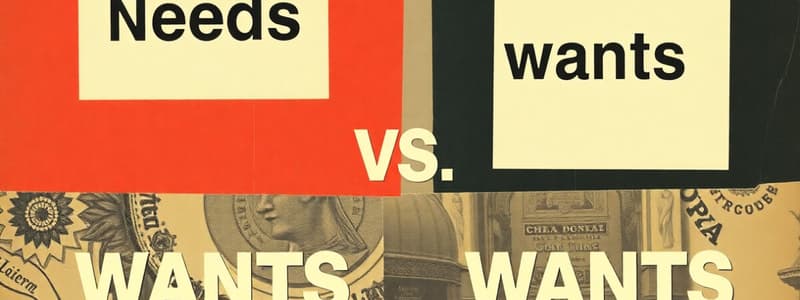Podcast
Questions and Answers
Which of the following is an example of a need?
Which of the following is an example of a need?
- A designer handbag
- A smartphone
- Food (correct)
- A luxury car
Wants are essential for survival.
Wants are essential for survival.
False (B)
What is opportunity cost?
What is opportunity cost?
the value of the next best alternative that you sacrifice when you make a decision
Resources are ______, but human wants are unlimited.
Resources are ______, but human wants are unlimited.
Match the following resources with their types:
Match the following resources with their types:
Which of the following is a capital resource?
Which of the following is a capital resource?
Countries can produce all the goods and services their citizens desire because they have unlimited resources.
Countries can produce all the goods and services their citizens desire because they have unlimited resources.
Why do societies need to make choices about how to allocate resources?
Why do societies need to make choices about how to allocate resources?
A vacation trip is an example of a ______.
A vacation trip is an example of a ______.
Which of these options are correct? (Select all that apply)
Which of these options are correct? (Select all that apply)
Which of the following is NOT a main factor influencing economic choices countries make?
Which of the following is NOT a main factor influencing economic choices countries make?
In a planned economy, supply and demand are the primary drivers of economic decisions.
In a planned economy, supply and demand are the primary drivers of economic decisions.
What is the fundamental economic problem that every society faces?
What is the fundamental economic problem that every society faces?
When a country spends money on military defense, the potential sacrifice in healthcare or education spending represents the ______.
When a country spends money on military defense, the potential sacrifice in healthcare or education spending represents the ______.
Match the following economic concepts with their descriptions:
Match the following economic concepts with their descriptions:
Which economic system relies primarily on the government to make decisions about resource allocation?
Which economic system relies primarily on the government to make decisions about resource allocation?
Countries can produce everything they need domestically and do not need to engage in international trade.
Countries can produce everything they need domestically and do not need to engage in international trade.
What is the term for the reliance of countries on each other for goods and services they cannot efficiently produce themselves?
What is the term for the reliance of countries on each other for goods and services they cannot efficiently produce themselves?
The United States operates under a ______ economy, where supply and demand play a significant role.
The United States operates under a ______ economy, where supply and demand play a significant role.
Why must countries make choices about what to produce?
Why must countries make choices about what to produce?
Flashcards
Needs
Needs
Basic essentials for survival and well-being, such as food, water, and shelter.
Wants
Wants
Non-essential desires that enhance comfort and enjoyment, like luxury items or vacations.
Scarcity
Scarcity
The fundamental economic problem where resources are limited but wants are unlimited.
Opportunity Cost
Opportunity Cost
Signup and view all the flashcards
Decision-Making
Decision-Making
Signup and view all the flashcards
Resource Types
Resource Types
Signup and view all the flashcards
Natural Resources
Natural Resources
Signup and view all the flashcards
Human Resources
Human Resources
Signup and view all the flashcards
Capital Resources
Capital Resources
Signup and view all the flashcards
Entrepreneurial Resources
Entrepreneurial Resources
Signup and view all the flashcards
Economic Systems
Economic Systems
Signup and view all the flashcards
Market Economy
Market Economy
Signup and view all the flashcards
Planned Economy
Planned Economy
Signup and view all the flashcards
Global Interdependence
Global Interdependence
Signup and view all the flashcards
Trade-offs
Trade-offs
Signup and view all the flashcards
Basic Economic Problem
Basic Economic Problem
Signup and view all the flashcards
Resource Allocation
Resource Allocation
Signup and view all the flashcards
Prioritization
Prioritization
Signup and view all the flashcards
Study Notes
Needs vs. Wants
- Needs: Fundamental for survival and well-being (e.g., food, water, shelter, clothing, healthcare, education). Essential and non-negotiable.
- Wants: Desires that enhance life but aren't essential (e.g., smartphone, designer handbag, luxury car). Based on personal preferences and vary between individuals.
- Key Difference: Needs are survival essentials, wants enhance quality of life.
Limited Resources and Decision-Making
- Scarcity: Resources (natural, human, capital, entrepreneurial) are finite, but wants are unlimited. This necessitates decision-making.
- Opportunity Cost: Choosing one option means sacrificing another. The value of the next best alternative is the opportunity cost. Example: Choosing a concert ticket means missing a new jacket.
- Decision-Making Impact: Scarcity forces societies to make choices on how to best use limited resources to maximize satisfaction and well-being.
Limits to a Country's Desires
- Scarcity: Countries, like individuals, face resource constraints (e.g., labor, capital, natural resources). Production limits exist.
- Opportunity Cost: Prioritization is essential. Spending on one area (e.g., military) may reduce spending in another (e.g., healthcare).
- Economic Systems: Different economic systems (market, planned) still involve trade-offs.
- Global Interdependence: Trade allows for access to goods, but comes with costs and challenges.
- Basic Economic Problem: The fundamental difficulty of choosing what to produce, how to produce, and for whom to produce in a world of finite resources.
- Key Takeaway: Limited resources constrain countries in achieving all their desired goods and services. Choices must be made to allocate resources efficiently.
Studying That Suits You
Use AI to generate personalized quizzes and flashcards to suit your learning preferences.




